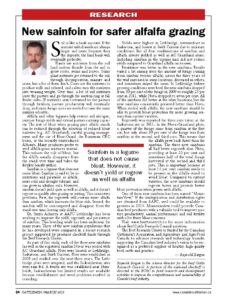New Sainfoin for Safer Alfalfa Grazing
This article written by Dr. Reynold Bergen, BCRC Science Director, originally appeared in the March 2013 issue of Canadian Cattlemen magazine and is reprinted with permission.
Soil is like a bank account. If the nutrient withdrawals are always larger and more frequent than the deposits, the land bank will eventually go broke.
Plants use nutrients from the soil (and carbon dioxide from the air) to grow roots, stems and leaves. Some plant nutrients get returned to the soil through decomposition, manure and urine, but a lot of them don’t. Cows use the nutrients to produce milk and rebreed, and calves turn the nutrients into weaning weight. Over time, a lot of soil nutrients leave the pasture and go through the auction ring at fall feeder sales. If nutrients aren’t returned to the pasture through fertilizer, pasture productivity will eventually drop, and more forage acres are needed to raise the same number of cattle.
Alfalfa and other legumes help restore soil nitrogen, increase forage yields and extend pasture carrying capacity. The risk of bloat when grazing pure alfalfa stands can be reduced through the selection of reduced bloat varieties (e.g. AC Grazeland), careful grazing management and the use of Bloat-Guard, the Rumensin CRC bolus, or the recently reintroduced Alfasure. Many producers prefer to seed alfalfa-grass mixtures instead. This reduces the risk of bloat, but the alfalfa usually disappears from the stand over time and takes the fertility benefit with it.
Sainfoin is a legume that does not cause bloat. Sainfoin is said to be as nutritious and palatable as alfalfa, more cold and drought tolerant, and can grow in alkaline soils. However, sainfoin doesn’t yield quite as well as alfalfa, and it doesn’t regrow as quickly after grazing or cutting. This causes two problems. First, the regrowth will contain more alfalfa than sainfoin, which increases the bloat risk. Second, the sainfoin will be outcompeted and disappear from the stand over time, leaving only alfalfa.
Dr. Surya Acharya at AAFC Lethbridge has been working to improve the yield, regrowth and persistence of sainfoin. This breeding work has been underway for many years. Three of the new sainfoin populations that he has developed were compared in a recent research project supported by producer checkoff funds through the Beef Research Cluster.
As part of this study, each of the three new sainfoins (as well as the registered sainfoin Nova) was seeded with AC Grazeland alfalfa. Plots were located at Lethbridge, Saskatoon, and Swift Current. Plots were established in 2008 and studied over the next three years. The Lethbridge plots were irrigated, and the Saskatchewan sites were rain fed. A fourth site was established near Humboldt, Saskatchewan but limited results are available because establishment and weed problems resulted in reseeding.
Yields were highest in Lethbridge, intermediate in Saskatoon, and lowest in Swift Current due to moisture conditions. But all four combinations of sainfoin and alfalfa always yielded as well as AC Grazeland alone. Including sainfoin in the legume mix did not reduce yields compared to Grazeland alfalfa on its own.
Persistence was better in the new sainfoins. Results varied a bit among sites; the amount of forage coming from sainfoin (versus alfalfa) across the three years of the trial increased in some locations, decreased in others, and sometimes stayed the same. In Lethbridge (where growing conditions were best) the new sainfoins dropped from 50 per cent of the forage in 2009 to roughly 25 per cent in 2011, while Nova dropped to seven per cent. All of the sainfoins did better at the other locations, but the new sainfoins consistently persisted better than Nova. When seeded with alfalfa, the new sainfoins should be able to provide bloat protection for more growing seasons than current varieties.
Regrowth was reported for three cuts taken at the Saskatoon site in 2011. In the Nova+Grazeland plots, a quarter of the forage came from sainfoin at the first cut, but only about 10 per cent of the forage was from sainfoin at the second and third cuts. This means that the alfalfa grew back faster than the sainfoin. The three new sainfoins all had better regrowth than Nova, providing at least 20 per cent and sometimes half of the total forage harvested at the second and third cuts. This is important because at least 15 per cent sainfoin needs to be present in the alfalfa stand to avoid bloat. Compared to current varieties, the new sainfoins should regrow faster and provide better bloat prevention when grown with alfalfa.
One of these new sainfoins has been named “MountainView.” If the multiplication and distribution rights are obtained from AAFC, seed could be available to growers in 2015. Mountainview could provide Canadian beef producers with a valuable tool to improve pasture productivity, animal performance and soil fertility with a lot fewer bloat concerns.
We welcome your questions, comments and suggestions. Contact us directly at [email protected] or generate public discussion by posting your thoughts below.
Stay connected by following us on Twitter @BeefResearch, liking us on Facebook, and subscribing to our YouTube Channel.
